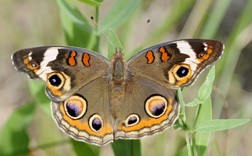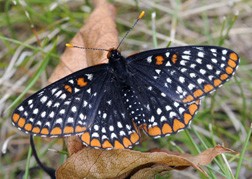Aerial Flowers: Butterflies
- Share
- Tweet
- Pin
- Share

This Buckeye Butterfly is an uncommon species and may not be found every summer.
Yesterday, May 26, 2015, I saw my second butterfly of the season, a Common Sulphur. A Mourning Cloak was the first. Few wild creatures interest and excite me more than gentle, common and beautiful butterflies. They don’t chase after you, bite or sting you and they cannot transmit diseases.
I look at butterflies as aerial flowers, radiant wings with golden freckles, lazily flying, fluttering, frolicking and basking in the sunshine, the perfect examples of peacefulness and tranquility. I know of a “secret” road and adjoining fields that could very well be called Butterfly Vale, the most perfect place in which I have enjoyed life in past years beneath a summer sky.
Indeed, butterflies are insects of sunny days. They would be good examples of “sun worshippers” in that you seldom see them on overcast days. It is almost as though the sun provides them with the power of flight.
Dave Tylka said in his fine Missouri Dept. of Conservation booklet, Butterfly Gardening and Conservation, “Butterflies go wherever they please and please wherever they go.” Yet they have the uncanny ability to locate very specific host plants upon which to lay their eggs. People who specialize in the study of butterflies and moths, too, are usually very good botanists and rank among my best looked-up-to friends.
Last summer we were able to capture some rather uncommon night-flying moths because we knew where some patches of Sweet Gale (Myrica gale) grew. Large stretches of wild Shrubby Cinquefoil (Potentilla fruiticose) produced quite a rare little-understood Wisconsin butterfly, too, the Dorcas Copper. Here again, knowing the host plant helped us to locate this small northern beauty.
Approximately 138 species of butterflies have been collected in Wisconsin. Not all are permanent residents here, a few having strayed into the state. Others, existing in collections today, may have been inhabitants of this state years ago but, due to various changes brought about by people, have disappeared from Wisconsin.

A Baltimore Checkerspot landed on a dry leaf in our yard and luckily Roy had his camera ready.
Door County, as an example, during an average summer should produce between 40 and 50 species of butterflies. Some, like the Dorcas Copper or Compton’s Tortoise-shell, are very rare while others, including the Mourning Cloak and Banded Purple, are quite common.
One species of butterfly that evaded me for years is the Baltimore Checkerspot. My study of this evasive creature indicates that it is extremely fussy about where it lives and is never to be found very far from its host plant, the Turtlehead (Chelone glabra), pronounced shah-LOW-nee GLAB-ra. The Turtlehead, a plant of wet places including ditches, does grow quite freely in our area but for some unknown reasons hasn’t lured many Baltimores to them. I finally photographed my first one several years ago.
Butterflies, or general groups of them, that we expect to see from April through late fall include, the Red Admiral, Painted Lady, the Fritillaries, Wood Nymphs and Satyrs, Angle-wings, Tortoise-shells, Skippers, Blues, Hairstreaks, Sulfurs, Pearl Crescent, Harvester, Coppers, Red-spotted Purple, Buckeye, Mustard White, Swallowtails, Monarch and Viceroy.
Butterflies capable of surviving our winters have always amazed me. These include the Painted Lady, Red Admiral, the Angle-wings such as the “Comma,” and the Tortoise-shells including the well-known Mourning Cloak. How thrilled we are, often during the spring period of maple syrup making, to see a Mourning Cloak winging its way through the woods on a sunny day when in a few places snow still lingers. They are capable of flight as long as the air temperature is at least 50 degrees F. or higher.
In all my years of teaching I’ve placed much emphasis on cultivating in children admiration and respect for butterflies and other small creatures, thereby helping them to become aware and sensitive adults.
Could you imagine the requirements for high school graduation including the recognition of 25 species of butterflies, their caterpillars and host plants? I can! After all, these young adults will someday be responsible for leadership and for caring for their environment. They might as well know something about it. Why not begin at the bottom for a change and learn the basics such as the birds, trees, wildflowers, ferns and butterflies that exist in their county, including in their own backyards?
How healthy is your community? Are there many species of butterflies there? These fragile insects can serve as a national or even global barometer of a clean environment. At times I get to wishing that every form of wildlife could somehow be monitored. Very few people show more than a passing interest in butterflies. Consequently there are only a few accurate countywide or statewide annual observations and counts made.

The bright yellow Canadian Swallowtail might be mistaken for the Eastern Tiger Swallowtail.
Yearly destructive changes brought about to the environment through development, road construction, drainage of wetlands, and use of pesticides are bound to have detrimental effects upon these harmless creatures. How about the effects upon people?
How great it would be if the acceptance of certain of man’s ways of life would be geared to their detrimental effect upon any and all forms of wildlife. The very first sign of upsetting any wild animal’s natural food chain or niche in the realm of life, and out this human “invention” would go – forever!
Many facets of our lifestyles are becoming very arbitrary and irrelevant. It is my belief that we all would be much better off if we slowed down, lived more simply, and spent more time studying the butterflies every summer. And remember, butterflies are light and delicate, but are powerful reminders of how fragile our planet Earth is.



